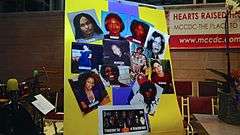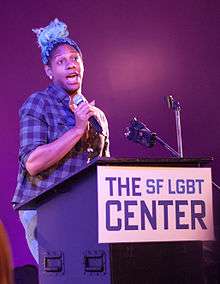International Transgender Day of Remembrance
| International Transgender Day of Remembrance | |
|---|---|
 A memorial at a Transgender Day of Remembrance event in Washington, D.C. | |
| Observed by | Transgender community and supporters |
| Type | international, cultural |
| Date | November 20 |
| Frequency | Annual |
| First time | 1999 |
| Related to | Transgender Awareness Week |
International Transgender Day of Remembrance (TDoR), which occurs annually on November 20, is a day to memorialize those who have been murdered as a result of transphobia[1] and to bring attention to the continued violence endured by the transgender community.[2]
The Transgender Day of Remembrance was founded in 1999 by Gwendolyn Ann Smith, a transgender woman,[3] to memorialize the murder of transgender woman Rita Hester in Allston, Massachusetts.[4] Since its inception, TDoR has been held annually on November 20,[5] and it has slowly evolved from the web-based project started by Smith into an international day of action. In 2010, TDoR was observed in over 185 cities throughout more than 20 countries.[6]
Typically, a TDoR memorial includes a reading of the names of those who lost their lives during the previous year,[7] and may include other actions, such as candlelight vigils, art shows, food drives, film screenings, and marches.[8] The Gay & Lesbian Alliance Against Defamation (GLAAD) has extensively covered TDoR.[9] GLAAD has interviewed numerous transgender advocates[10] (including actress Candis Cayne[11]), profiled an event at the New York City LGBT Community Center,[12] and discussed media coverage of TDoR.[13]
Race, TDoR, and Trans Women of Color

While TDoR is a critical event, scholars and activists committed to advancing intersectional approaches to trans politics continue to highlight the importance of seeing transphobic violence as inherently connected to race, gender, and class. This is reflected in the disproportionate instances of violence against trans women of color in general and Black trans women in particular.[14][15][16]
Theorists C. Riley Snorton and Jin Haritaworn incisively critique how images and narratives centering on the deaths of trans people of color—most often transfeminine bodies of color—are circulated within social movements and spaces headed by white gay and trans activists, such as TDoR.[17] Reflecting on the case of African American trans woman Tyra Hunter, Snorton and Haritaworn observe the dangers of positioning trans women and transfeminine bodies of color as legible only in the aftermath of their deaths, and failing to see such violence as effects of both systematic transphobia and racism. Resonating alongside (but not limited to) trans activists CeCe McDonald, Reina Gossett, Sylvia Rivera, and Dean Spade, Snorton and Haritaworn's work advocates for the importance of an intersectional approach to events such as TDoR and transgender activism in general.
Scholar Sarah Lamble (2008) argues that TDoR's focus on a collective mourning risks producing the white spectator as innocent of, rather than complicit in, the violence that produces the deaths of trans women of color they are mourning. Lamble states that: "Our task then is to push these further—not only with respect to TDOR but also in the many ways we recount and confront violence. None of us are innocent. We must envision practices of remembrance that situate our own positions within structures of power that authorize violence in the first place. Our task is to move from sympathy to responsibility, from complicity to reflexivity, from witnessing to action. It is not enough to simply honor the memory of the dead—we must transform the practices of the living"[18] (38).
Transgender activist Mirha-Soleil Ross criticizes TDoR for conflating the motivation behind the murders of transgender women sex workers. In an interview with scholar Viviane Namaste, she presents examples of transgender sex workers who were murdered in Toronto for being sex workers and accuses the organizers of TDoR of using these women who died for being sex workers as martyrs of the transgender community.[19]
See also
References
- ↑ "Trans Day of Remembrance". Massachusetts Transgender Political Coalition. 2013. Retrieved 2013-11-20.
- ↑ Millen, Lainey (2008-11-20). "North Carolinians mark Transgender Remembrance Day". QNotes.
- ↑ Smith, G. "Biography". Gwensmith.com. Retrieved 2013-11-20.
- ↑ Jacobs, Ethan (2008-11-15). "Remembering Rita Hester". EDGE Boston.
- ↑ "Transgender Day of Remembrance". Human Rights Campaign. Retrieved 2013-11-20.
- ↑ St. Pierre, E. (2010). TDoR Events and Locations 2010. Transgenderdor.org.
- ↑
- "St. Louis Observes Transgender Day of Remembrance". Vital Voice. 2012.
- "Transgender deaths commemorated at Brighton vigil". BBC News. 2010-11-21.
- ↑ Gonzalez, Yvonne (2010-11-18). "Groups recognize transgender remembrance day". The State Press. Archived from the original on November 22, 2010.
- ↑
- GLAAD (2008-11-17). "An Introduction to the Transgender Day of Remembrance". GLAAD. Retrieved 2011-03-07.
- GLAAD (2008-11-20). "Transgender Day of Remembrance is Today". GLAAD. Retrieved 2011-03-07.
- GLAAD (2008-11-20). "The 10th Annual Transgender Day of Remembrance". GLAAD. Retrieved 2011-03-07.
- GLAAD (2009-11-16). "An Introduction to Transgender Day of Remembrance 2009". GLAAD. Retrieved 2011-03-07.
- GLAAD (2009-11-16). "Law & Social Change: The True Significance of the Transgender Day of Remembrance". GLAAD. Retrieved 2011-03-07.
- GLAAD (2009-11-20). "Nov 20th – The Eleventh Annual Transgender Day of Remembrance". GLAAD. Retrieved 2011-03-07.
- GLAAD (2010-11-19). "The Importance of the Transgender Day of Remembrance". GLAAD. Retrieved 2011-03-07.
- GLAAD (2010-11-19). "Transgender Day of Remembrance: Honoring the Lives Lost". GLAAD. Retrieved 2011-03-07.
- GLAAD (2010-11-20). "Obama Appointee Amanda Simpson Speaks at D.C. Day of Remembrance Event". GLAAD. Retrieved 2011-03-07.
- ↑
- GLAAD (2008-11-18). "Autumn Sandeen – "What Does Transgender Day of Remembrance Mean to You?"". GLAAD. Retrieved 2011-03-03.
- GLAAD (2008-11-19). "Helen Boyd – "What Does Transgender Day of Remembrance Mean to You?"". GLAAD. Retrieved 2011-03-03.
- GLAAD (2008-11-20). "Shannon Garcia – "What Does Transgender Day of Remembrance Mean to You?"". GLAAD. Retrieved 2011-03-03.
- GLAAD (2008-11-20). "Elizabeth Rivera – "What Does Transgender Day of Remembrance Mean to You?"". GLAAD. Retrieved 2011-03-03.
- GLAAD (2008-11-21). "Jillian Barfield – "What Does Transgender Day of Remembrance Mean to You?"". GLAAD. Retrieved 2011-03-03.
- GLAAD (2008-11-21). "Amanda Morgan – "What Does Transgender Day of Remembrance Mean to You?"". GLAAD. Retrieved 2011-03-03.
- GLAAD (2008-11-21). "Gael Guevara – "What Does Transgender Day of Remembrance Mean to You?"". GLAAD. Retrieved 2011-03-03.
- GLAAD (2008-12-01). "Monica Canfield Lenfest – "What Does Transgender Day of Remembrance Mean to You?"". GLAAD. Retrieved 2011-03-03.
- GLAAD (2009-11-17). "What Does Transgender Day of Remembrance Mean to You? – Stefanie Rivera". GLAAD. Retrieved 2011-03-03.
- GLAAD (2009-11-18). "What Does Transgender Day of Remembrance Mean to You? -Monica Roberts". GLAAD. Retrieved 2011-03-03.
- GLAAD (2009-11-19). "What Does Transgender Day of Remembrance Mean to You? -Sassafras Lowrey". GLAAD. Retrieved 2011-03-07.
- GLAAD (2009-11-20). "What Does Transgender Day of Remembrance Mean to You – Q&A with Ethan St. Pierre". GLAAD. Retrieved 2011-03-07.
- ↑ GLAAD (2009-11-20). "Exclusive Video: Candis Cayne Discusses Being Out as Transgender in Hollywood". GLAAD. Retrieved 2011-03-07.
- ↑ GLAAD (2010-11-20). "New York City's LGBT Center Observes Transgender Day of Remembrance". GLAAD. Retrieved 2011-03-03.
- ↑
- GLAAD (2008-11-21). "Transgender Day of Remembrance's International Scope". GLAAD. Retrieved 2011-03-07.
- GLAAD (2008-11-24). "Media Coverage of Transgender Day of Remembrance Grows, Remains Respectful". GLAAD. Retrieved 2011-03-07.
- GLAAD (2009-11-18). "Remembering the Need for Accurate Reporting on Trans Stories". GLAAD. Retrieved 2011-03-07.
- GLAAD (2010-11-19). "Transgender Day of Remembrance: The Role of the Media". GLAAD. Retrieved 2011-03-07.
- GLAAD (2010-11-23). "NC Radio Station Corrects Anti-Transgender Coverage". GLAAD. Retrieved 2011-03-07.
- ↑ National Coalition of Anti-Violence Programs (http://www.avp.org/storage/documents/Reports/2014_HV_Report-Final.pdf). "Lesbian, Gay, Bisexual, Transgender, Queer, and HIV-Affected Hate Violence in 2014" (PDF). Retrieved March 19, 2016. Check date values in:
|date=(help) - ↑ "Black Trans* Women's Lives Matter". Retrieved March 19, 2016.
- ↑ Vincent, Addison Rose (August 13, 2015). "State of Emergency Continues for Trans Women of Color". Retrieved March 19, 2016 – via Huffington Post.
- ↑ C. Riley Snorton and Jin Haritaworn (2013). Trans necropolitics: A transnational reflection on violence, death, and the trans of color afterlife. The Transgender Studies Reader 2: New York: Routledge Press. pp. 66–76.
- ↑ Lamble, Sarah (2008). "Retelling racialized violence, remaking white innocence: The politics of interlocking oppressions in Transgender Day of Remembrance". Sexuality Research and Social Policy: Journal of NSRC. Retrieved March 19, 2016.
- ↑ Namaste, Viviane (2011). Sex Change, Social Change. Women's Press. ISBN 9780889614833.
Further reading
- Smith, Gwendolyn Ann. "Transgender Day of Remembrance: Rita Hester and Beyond", Huffington Post, 2013-11-20.
External links
- International Transgender Day of Remembrance
- Transgender Day Of Remembrance - Manchester, UK
- Trans Day of Remembrance UK